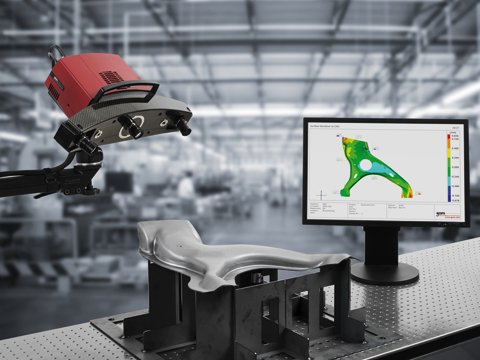Quality assurance and management are increasingly important in industrial development and manufacturing. Modules manufactured decentralized by suppliers must meet specifications and guarantee smooth integration into centralized final production to provide a high quality finished product. Optical digitizing systems are firmly established for the inspection of individual metal sheets, assembly analysis, as well as for testing forming dies.
In addition to other industrial sectors, the automotive industry is one of the most important users of GOM systems. They are largely used in product development and quality assurance as well as material and component testing, and are increasingly replacing tactile measuring equipment which was only able to test metal sheets at few points for time limitations. In contrast, optical 3D measuring technology can capture the entire component surface geometry in a high-resolution point cloud.
The 3D ATOS measuring system is the current state-of-the-art GOM system in this field. It enables high-precision optical 3D measurement of sheet metal components and is used both by consumer goods companies and the automotive industry, for example, BMW, Audi or Volkswagen, as a precise, fast, and robust measurement solution. The ATOS system combines a high quality of data measurement and flexibility and cannot only be used in a measurement room, but is also mobile and can be used on site in the press works and in a harsh production environment. Precise 3D coordinates can be generated for different object sizes, together with complete measurement and test reports.
## Guided feature detection
Until recently the measurement of sharp edges was only possible with contact measurement scanners as these could not be measured adequately with optical digital systems. However, by developing the entire sensor, measuring and inspection software in-house, GOM were now able to provide an integrated concept with safeguarded workflow specifically for sheet metal inspection. The image processing components used by GOM in the ATOS system are supplied by STEMMER IMAGING and both companies worked together closely in the selection of suitable products.
Typical features such as hole patterns as well as trim and springback at borders are measured in ATOS using the »Guided Feature Measurement-Strategy«. Using previously extracted inspection characteristics from the CAD, the software shows the user the best sensor positions, for example, where an elongated hole can best be measured. Sharp-edged characteristics can now be measured reliably with sub-pixel precision, based on specifically developed algorithms.
Intrinsically stable parts can be measured without fixtures with the contact-free ATOS Digitizer as the alignment of measured data with the CAD data is controlled via so-called RPS points in the ATOS inspection software. Once a sheet metal component has been digitized both free-standing and assembled, deformation can be measured and visualized. Variable alignment is given by the dense data volume and contributes to fast problem-solving during assembly analysis.
For the measurement of clamped sheet metal components the contact-free measuring technique enables an adaptive fixture concept, thus saving costly gauges. For example, a simple holding jig can replace six measuring gauges. As this can be used in parallel for different assemblies, this saves storage space and production time.
## Parametric inspection software
The ATOS inspection software developed by GOM enables the import of CAD formats as well as classic measuring plans such as Catia-List or DMIS. In addition, inspection characteristics which are already incorporated in the CAD data, such as surface tolerances, profile, shape, and position tolerances, can also be entered.
After alignment, the deviation of each data point to the CAD can be determined and a full surface color 3D display of the deviations to the CAD can then be created using the digitized measuring data. Local deviations of the components can be analyzed using inspection sections.
Thus the ATOS system allows a number of checks which include checking of borders, surface target/actual comparisons, trim & springback, and hole pattern sample measurements, as well as an analysis of gap and flush. The output of the measured results can be created in configurable reports using different image or value displays. In addition, the free GOM Inspect 3D Viewer supports the comprehensive use of 3D coordinate measuring data and its evaluation. All 3D measuring data and inspection results are available in compact format for exchange and further processing by customers or colleagues.
Flexible, automated inspection cells, which are common in the automotive industry, can be realized in conjunction with robots, turntables and linear positioning units. Full-surface component measurement allows for straightforward go/no go statements and also shows the course of deviations for a fast evaluation of processes. Potential problems can thus be detected early and corrected in time, resulting in lower production costs and efficient quality control.
## Advantage through optical 3D measuring technology
Companies employing optical measurement technology benefit from shorter product development cycles and shorter production start-up times. Companies remain competitive as they are able to help their customers to go from the idea to the product quicker. At the same time they can optimize production processes and minimize rejects during running production. The single-source, comprehensive approach from measuring hardware to evaluating inspection software with training and support represents a significant benefit when using automated measuring cells.
## GOM: the 3D specialists
Since 1990, GOM Gesellschaft für Optische Messtechnik (www.gom.com) develops and distributes optical measuring systems and inspection software packages with a focus on 3D digitizing, 3D coordinate measuring technology, deformation analyses and quality control. The systems are employed in product development and quality assurance, as well as in material and component inspection.
Users of GOM systems include companies worldwide from the automotive industry, the aerospace industry, the consumer goods industry, as well as their suppliers. A number of research institutes and universities are also customers. The company is one of STEMMER IMAGING's biggest customers.
For further links see also
http://www.stemmer-imaging.de/...

